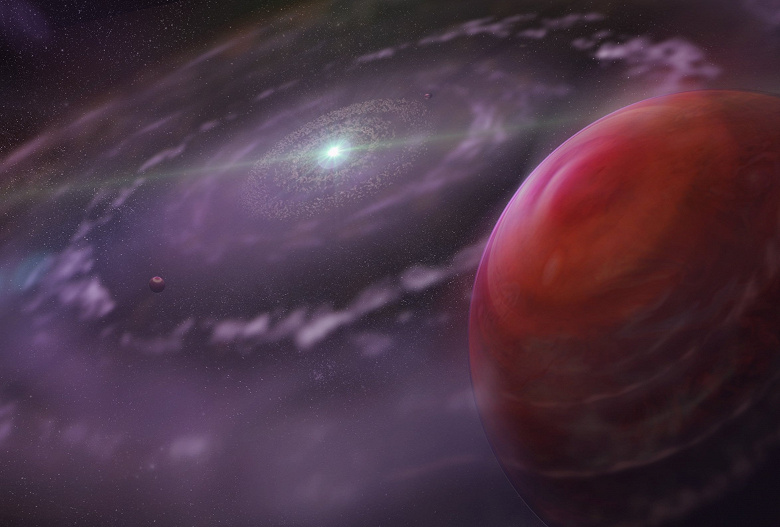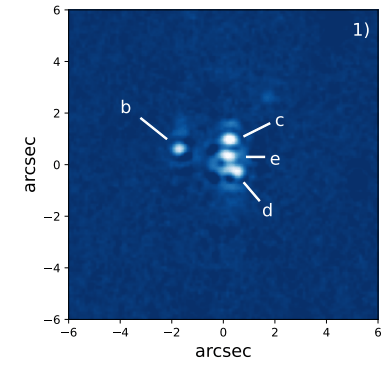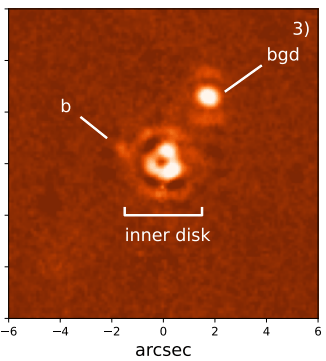The MIRI instrument on board JWST helped study one particularly interesting star system, HR 8799. The observations provided data for analyzing the chemical composition of the atmospheres of four exoplanets in this young star system
When the JWST space telescope first saw the light in July 2022, it was witnessing a huge research program put together by members of the International Astronomical Union. This list included distant early galaxies, forming planets in gas and dust protoplanetary disks, as well as the end of the “dark ages of the Universe” and the first light. Among the numerous targets, exoplanets could not be absent from the list.
One distant star system has particularly fascinated scientists. 15 years ago, astronomers discovered three exoplanets around the star HR 8799, located approximately 133 light years from Earth. Later, a fourth exoplanet was discovered, all planets were found by direct detection. These are massive planets with wide orbits, which is rare. Also, the HR 8799 system is attractive for observations because it belongs to young stellar systems.

That’s why JWST recently observed this system. Thanks to its instruments, including the MIRI infrared instrument and the coronagraph, it was able to provide data that allowed it to study the star system in more detail.
The mass of HR 8799 exceeds 1.5 solar masses, and the luminosity of this star is almost five times that of the Sun. A dust disk has formed around it, and it is a fairly young star – its age is only about 30 million years. Young solar systems are of particular interest because they reveal details about the formation of planets. A new study, authored by Anthony Bocaletti from the Observatory of Paris, was aimed at studying these details.
The HR 8799 system includes four planets: HR 8799 b, c, d, and e. They are all massive giants with masses ranging from 5.7 to 9.1 Jupiter masses—the mass boundaries of brown dwarfs—objects that have characteristics between planets and stars. The planets’ orbits range from 16 to 71 astronomical units, and their orbital periods range from 45 to 460 years. The fact that they were discovered 15 years ago is also significant because astronomers have an accumulated history of observations of the HR 8799 system.
The discovery of massive giant planets with orbits greater than 5 astronomical units is rare. Therefore, every discovery of such systems is important. Thanks to the capabilities provided by the MIRI instrument, JWST can shed light on unknown aspects of such systems and allow scientists to more fully characterize them. Until recently, technical difficulties in mid-infrared observations have made the detailed study of the HR 8799 system challenging.
JWST helped study exoplanets of the HR 8799 system

With JWST, scientists were able to refine information obtained from previous observations and gain a clearer understanding of various aspects of the system. The main focus has been on more accurately characterizing the atmospheres of exoplanets.
Despite some uncertainty about their composition and the open question of whether they are brown dwarfs, the JWST observations were able to remove doubts. With planetary temperatures ranging from 900 K to 1300 K, new measurements show that the temperature of planet HR 8799 b is lower than previous measurements suggested. Also, the MIRI instrument was able to unambiguously detect the presence of two chemical compounds in the atmospheres of exoplanets: water and carbon monoxide. In addition, according to the data, scientists have controversial evidence of methane detection, which is additional evidence that these objects are planets and not brown dwarfs, since the latter always clearly exhibit methane content at such temperatures.
The MIRI (Mid-Infrared Instrument) instrument was designed with the potential to apply various filters. Some of them were specifically designed to detect ammonia, as this could be an indicator of the presence of precursors to life on exoplanets. However, data from the four planets in the HR 8799 system showed that they were slightly hotter than the temperature at which ammonia would be expected to be present.

In addition, the HR 8799 system is notable for the presence of a dust disk that has two belts. Researchers wondered whether the inner edge of the outer belt could indicate the presence of a fifth planet with a mass between Jupiter and Saturn, or whether it was simply a collection of dust. This led to a debate that was resolved by JWST observations. The researchers concluded that the inner edge of the outer belt is a background object unrelated to HR 8799.
This was JWST’s first opportunity to study a young exoplanet system using the MIRI instrument, its filters, and its coronagraph. JWST’s MIRI instrument opens up new opportunities for high-contrast imaging in the mid-infrared and provides new avenues for the study of young exoplanetary systems. The main goal of the work was to conduct observations and test various algorithms to determine the best scenario for using the instruments and interpreting the results of future observations.
The data obtained will help optimize tool settings. Due to the high sensitivity of the MIRI coronagraph, it may be difficult to study young star systems with its help. This is only the first use of the instrument, and the extreme sensitivity of the coronagraph can make detecting and interpreting observations of young systems challenging, including potential confusion due to the appearance of background galaxy data.
The authors of the work note that ways for improvements have already been outlined, and their results will be useful for further improving observations and research.




